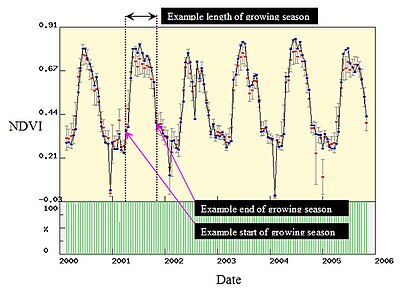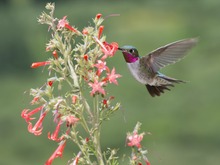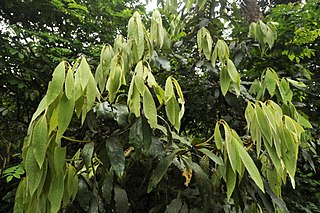Records
Historical

Observations of phenological events have provided indications of the progress of the natural calendar since ancient agricultural times. Many cultures have traditional phenological proverbs and sayings which indicate a time for action: "When the sloe tree is white as a sheet, sow your barley whether it be dry or wet" or attempt to forecast future climate: "If oak's before ash, you're in for a splash. If ash before oak, you're in for a soak". But the indications can be pretty unreliable, as an alternative version of the rhyme shows: "If the oak is out before the ash, 'Twill be a summer of wet and splash; If the ash is out before the oak, 'Twill be a summer of fire and smoke." Theoretically, though, these are not mutually exclusive, as one forecasts immediate conditions and one forecasts future conditions.
The North American Bird Phenology Program at USGS Patuxent Wildlife Research Center (PWRC) is in possession of a collection of millions of bird arrival and departure date records for over 870 species across North America, dating between 1880 and 1970. This program, originally started by Wells W. Cooke, involved over 3,000 observers including many notable naturalists of the time. The program ran for 90 years and came to a close in 1970 when other programs starting up at PWRC took precedence. The program was again started in 2009 to digitize the collection of records and now with the help of citizens worldwide, each record is being transcribed into a database which will be publicly accessible for use.
The English naturalists Gilbert White and William Markwick reported the seasonal events of more than 400 plant and animal species, Gilbert White in Selborne, Hampshire and William Markwick in Battle, Sussex over a 25-year period between 1768 and 1793. The data, reported in White's Natural History and Antiquities of Selborne [17] are reported as the earliest and latest dates for each event over 25 years; so annual changes cannot therefore be determined.
In Japan and China the time of blossoming of cherry and peach trees is associated with ancient festivals and some of these dates can be traced back to the eighth century. Such historical records may, in principle, be capable of providing estimates of climate at dates before instrumental records became available. For example, records of the harvest dates of the pinot noir grape in Burgundy have been used in an attempt to reconstruct spring–summer temperatures from 1370 to 2003; [18] [19] the reconstructed values during 1787–2000 have a correlation with Paris instrumental data of about 0.75.
Modern
Great Britain
Robert Marsham, the founding father of modern phenological recording, was a wealthy landowner who kept systematic records of "Indications of spring" on his estate at Stratton Strawless, Norfolk, from 1736. These took the form of dates of the first occurrence of events such as flowering, bud burst, emergence or flight of an insect. Generations of Marsham's family maintained consistent records of the same events or "phenophases" over unprecedentedly long periods of time, eventually ending with the death of Mary Marsham in 1958, so that trends can be observed and related to long-term climate records. The data show significant variation in dates which broadly correspond with warm and cold years. Between 1850 and 1950 a long-term trend of gradual climate warming is observable, and during this same period the Marsham record of oak-leafing dates tended to become earlier. [20]
After 1960 the rate of warming accelerated, and this is mirrored by increasing earliness of oak leafing, recorded in the data collected by Jean Combes in Surrey. Over the past 250 years, the first leafing date of oak appears to have advanced by about 8 days, corresponding to overall warming on the order of 1.5 °C in the same period.
Towards the end of the 19th century the recording of the appearance and development of plants and animals became a national pastime, and between 1891 and 1948 the Royal Meteorological Society (RMS) organised a programme of phenological recording across the British Isles. Up to 600 observers submitted returns in some years, with numbers averaging a few hundred. During this period 11 main plant phenophases were consistently recorded over the 58 years from 1891 to 1948, and a further 14 phenophases were recorded for the 20 years between 1929 and 1948. The returns were summarised each year in the Quarterly Journal of the RMS as The Phenological Reports . Jeffree (1960) summarised the 58 years of data, [21] which show that flowering dates could be as many as 21 days early and as many as 34 days late, with extreme earliness greatest in summer-flowering species, and extreme lateness in spring-flowering species. In all 25 species, the timings of all phenological events are significantly related to temperature, [22] [23] indicating that phenological events are likely to get earlier as climate warms.
The Phenological Reports ended suddenly in 1948 after 58 years, and Britain remained without a national recording scheme for almost 50 years, just at a time when climate change was becoming evident. During this period, individual dedicated observers made important contributions. The naturalist and author Richard Fitter recorded the First Flowering Date (FFD) of 557 species of British flowering plants in Oxfordshire between about 1954 and 1990. Writing in Science in 2002, Richard Fitter and his son Alistair Fitter found that "the average FFD of 385 British plant species has advanced by 4.5 days during the past decade compared with the previous four decades." [24] [25] They note that FFD is sensitive to temperature, as is generally agreed, that "150 to 200 species may be flowering on average 15 days earlier in Britain now than in the very recent past" and that these earlier FFDs will have "profound ecosystem and evolutionary consequences". In Scotland, David Grisenthwaite meticulously recorded the dates he mowed his lawn since 1984. His first cut of the year was 13 days earlier in 2004 than in 1984, and his last cut was 17 days later, providing evidence for an earlier onset of spring and a warmer climate in general. [26] [27] [28]
National recording was resumed by Tim Sparks in 1998 [29] and, from 2000, [30] has been led by citizen science project Nature's Calendar , run by the Woodland Trust and the Centre for Ecology and Hydrology. Latest research shows that oak bud burst has advanced more than 11 days since the 19th century and that resident and migrant birds are unable to keep up with this change. [31]
Continental Europe
In Europe, phenological networks are operated in several countries, e.g. Germany's national meteorological service operates a very dense network with approx. 1200 observers, the majority of them on a voluntary basis. [32] The Pan European Phenology (PEP) project is a database that collects phenological data from European countries. Currently 32 European meteorological services and project partners from across Europe have joined and supplied data. [33]
In Geneva, Switzerland, the opening of the first leaf of an official chestnut tree (a horse chestnut) has been observed and recorded since 1818, thus forming the oldest set of records of phenological events in Switzerland. [34] This task is conducted by the secretary of the Grand Council of Geneva (the local parliament), and the opening of the first leaf is announced publicly as indicating the beginning of the Spring. Data show a trend during the 20th century towards an opening that happens earlier and earlier. [35]
Other countries
There is a USA National Phenology Network in which both professional scientists and lay recorders participate.
Many other countries such as Canada (Alberta Plantwatch and Saskatchewan PlantWatch [36] ), China and Australia [37] [38] also have phenological programs.
In eastern North America, almanacs are traditionally used[ by whom? ] for information on action phenology (in agriculture), taking into account the astronomical positions at the time. William Felker has studied phenology in Ohio, US, since 1973 and now publishes "Poor Will's Almanack", a phenological almanac for farmers (not to be confused with a late 18th-century almanac by the same name).
In the Amazon rainforests of South America, the timing of leaf production and abscission has been linked to rhythms in gross primary production at several sites. [39] [40] Early in their lifespan, leaves reach a peak in their capacity for photosynthesis, [41] and in tropical evergreen forests of some regions of the Amazon basin (particularly regions with long dry seasons), many trees produce more young leaves in the dry season, [42] seasonally increasing the photosynthetic capacity of the forest. [43]














